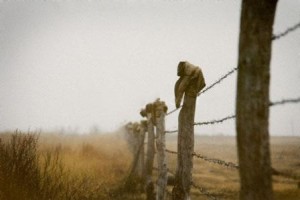 A lone tree stretches itself across the horizon. A tumbleweed brushes it before continuing its journey across the Texas landscape. Thousands of hooves kick up dust as they hurdle past. A group of hardy men on horses form a barrier around the animals and keep them all together in a single ocean of brown, sleek waves. The men drive the cattle into a fenced in area where a crowd of people have gathered. A man stands over the crowd, trying to yell above the noise about the wonders of his newest product. It’s 1876, the man is John Warne Gates, and he was working on ending the life of the American Cowboy.
A lone tree stretches itself across the horizon. A tumbleweed brushes it before continuing its journey across the Texas landscape. Thousands of hooves kick up dust as they hurdle past. A group of hardy men on horses form a barrier around the animals and keep them all together in a single ocean of brown, sleek waves. The men drive the cattle into a fenced in area where a crowd of people have gathered. A man stands over the crowd, trying to yell above the noise about the wonders of his newest product. It’s 1876, the man is John Warne Gates, and he was working on ending the life of the American Cowboy.
Barbed wire fences appeared in the United States in the 1860’s and their success swept across the the North. The South, fearing that the product might harm their cattle and reluctant to buy from the North, was hesitant to buy into the fad at first. When John Gates began demonstrating across Texas, southerners began to see how successful at containing cattle the barbs were. Cowboys had a number of jobs at this point in time, but their primary purpose was to tend cattle. They were in charge of moving cattle from place to place and keeping them inside rancher property. This was a tough job due to the ineffectiveness of fencing at the time, which was made out of high-maintenance hedges or flimsy wire tied to crooked tree branches. However, while barbed-wire fences were made of the same wire, they had barbs that deterred cattle from crossing after one or two attempts. The position of cowboy assumed that fences were ineffective at containing cattle and horses which was no longer the case. After John Gates showed the people of Texas the truth in this and soon barbed wire became just as popular as it was in the North.
Slowly, cowboys became less and less needed. A series of harsh winters killed hundreds of cows and damaged the cattle industry pretty substantially around that time and work as a cowboy was not profitable. Ranchers still required help around the farm, but they would more likely find help in farmhands than cowboys. Barbed wire did most of the cowboy’s job and with the low profits being made off cattle, the position on the ranch was no longer needed and could no longer be afforded. It is ironic that barbed wire is so often associated with cowboy culture because it was so closely intertwined with their end. However, while barbed wire killed the lifestyle, it couldn’t kill the culture. The South is still a home for cowboy culture in spirit and in practice. Cowboy hats, alcohol, and acoustic guitars still proudly riddle the southern landscape. To this day, the rest of the world calls Americans cowboys, barbed wire or not.

Leave a comment
Your email address will not be published. Required fields are marked *